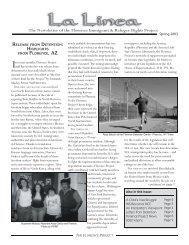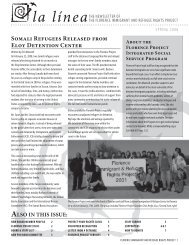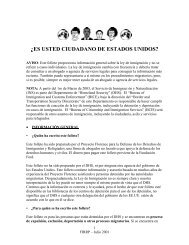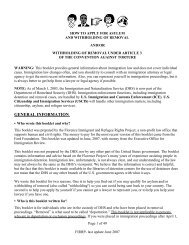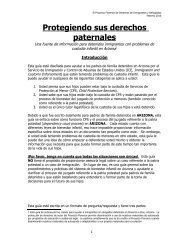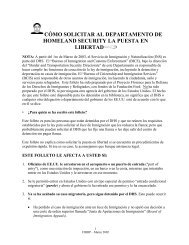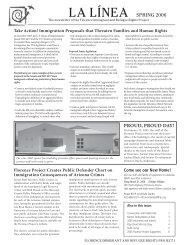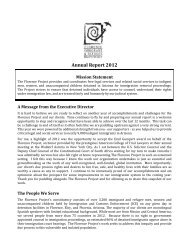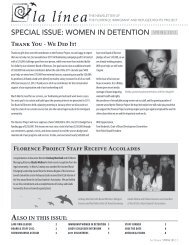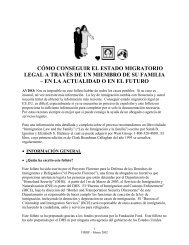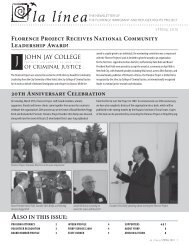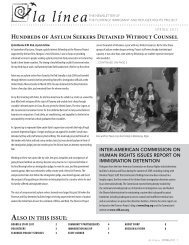quick reference chart and annotations for determining immigration ...
quick reference chart and annotations for determining immigration ...
quick reference chart and annotations for determining immigration ...
Create successful ePaper yourself
Turn your PDF publications into a flip-book with our unique Google optimized e-Paper software.
Immigrant Legal Resource Center, Florence Immigrant <strong>and</strong> Refugee Rights Project,<br />
Maricopa County Public Defender August 2012<br />
Crime Involving Moral Turpitude (CMT): Maybe not. Knowingly restraining another person,<br />
without more, arguably does not by its nature involve evil intent that amounts to moral turpitude.<br />
Unlawful imprisonment is distinguished from kidnapping by its lack of intent to do harm. See, e.g., State<br />
v. Lucas, 146 Ariz. 597, 604 (1985); State v. Flores, 140 Ariz. 469,473 (1984). A false imprisonment<br />
statute that does not require an intent to do harm should not be a CMT, although the Ninth Circuit has<br />
held that “violence, menace, fraud, or deceit”—which is similar to the requirement of “physical <strong>for</strong>ce,<br />
intimidation or deception” here—implies an intent to do harm. Saavedra-Figueroa v. Holder, 625 F.3d<br />
621, 626 (9th Cir. 2010). However, since the statute can also be violated by something other than<br />
“physical <strong>for</strong>ce, intimidation or deception” if the victim is a child or an incompetent adult, a vague record<br />
of conviction that does not specify the means by which the “restraint” was achieved should not be a CMT.<br />
See Saavedra-Figueroa v. Holder, 625 F.3d 621, 627 (9th Cir. 2010)<br />
Even if the record shows use of <strong>for</strong>ce, mere use of <strong>for</strong>ce (as opposed to <strong>for</strong>ce with intent to<br />
commit great bodily harm) does not necessarily involve moral turpitude. This section, <strong>for</strong> example, could<br />
be violated by a storeowner who unreasonably decided that a person had stolen something, <strong>and</strong> who<br />
detained the person as a shoplifter. If victim is a child could plead to §13-1302 Custodial Interference.<br />
Aggravated Felony: Crime of Violence. Counsel can avoid an aggravated felony by obtaining a<br />
sentence of 364 or less. Further, the offense is not necessarily a crime of violence, since it can be carried<br />
out by deceit. Keep the record free of <strong>reference</strong> to violence. The Ninth Circuit has held that kidnapping<br />
is not an aggravated felony crime of violence under 18 USC § 16(a) because it may be committed without<br />
the use or threat of violence, <strong>and</strong> the same arguments would apply here. United States v. Marquez-Lobos,<br />
683 F.3d 1061, 1066 (9th Cir. 2012) (citing State v. Bible, 175 Ariz. 549, 604, 858 P.2d 1152 (1993)). In<br />
Marquez-Lobos, the Ninth Circuit also noted that when the victim is a minor who is less than 18 years old<br />
or incompetent, a lack of consent may be established through non-acquiescence by the lawful custodian,<br />
which does not involved the use or threat of violence. Id. (citing State v. Viramontes, 163 Ariz. 334, 336,<br />
788 P.2d 67 (1990)). However, the government will argue that a felony offense is an aggravated felony<br />
under 18 USC § 16(b) because it creates a situation carrying an inherent risk that <strong>for</strong>ce will be used.<br />
Defense counsel should keep the record free of <strong>reference</strong> to <strong>for</strong>ce or intimidation in order to allow<br />
<strong>immigration</strong> counsel to argue against this.<br />
Other Ground: Domestic Violence <strong>and</strong> Child Abuse: A.R.S. § 13-1303 will be a “crime of<br />
domestic violence” <strong>and</strong> cause deportability under the DV ground only where (a) the record shows that the<br />
victim has the required domestic relationship, <strong>and</strong> (b) the offense is a “crime of violence” as defined in 18<br />
USC § 16. DHS will charge false imprisonment as a deportable domestic violence offense if §13-3601 is<br />
in the judgment. Counsel should attempt to avoid the § 13-3601 notation, as well as other evidence in the<br />
record of conviction showing a domestic relationship. However, if the offense is a misdemeanor <strong>and</strong> the<br />
record of conviction does not establish that <strong>for</strong>ce or threat of <strong>for</strong>ce was used (e.g., leaves open the<br />
possibility that the restraint was by deceit or other means), <strong>immigration</strong> counsel will have a strong<br />
argument that the conviction does not trigger deportation under that ground.<br />
A noncitizen is deportable under the DV ground if convicted of a crime of child abuse, neglect<br />
or ab<strong>and</strong>onment. Where possible, keep the victim’s age out of the record, <strong>for</strong> two reasons. First, if the<br />
record indicates that this is a child, the court may go to the record to see if the offense involved “abuse.”<br />
While false imprisonment of a child does not necessarily constitute abuse – it can be accomplished simply<br />
by transporting the child without the permission of the guardian – this still carries a risk. See Matter of<br />
Soram, 25 I&N Dec. 378 (BIA 2010) (unreasonably placing a child in a situation that poses a threat of<br />
injury to the child’s life or health is categorically a crime of child abuse even though no proof of actual<br />
harm or injury to the child is required). Second, leaving open the possibility that the victim was a child<br />
Arizona Criminal Chart with Explanatory Endnote – August 2012<br />
31



